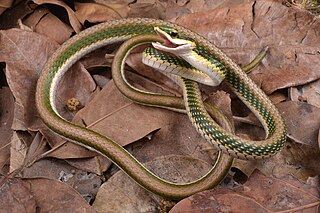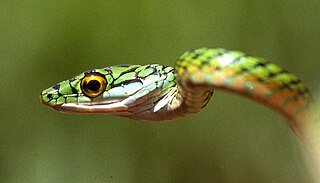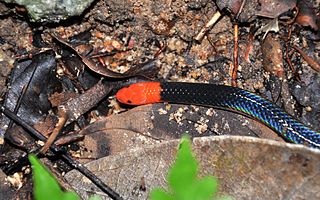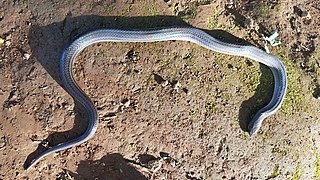
Boiga is a large genus of rear-fanged, mildly venomous snakes, known commonly as cat-eyed snakes or simply cat snakes, in the family Colubridae. Species of the genus Boiga are native to southeast Asia, India, and Australia, but due to their extremely hardy nature and adaptability, have spread to many other suitable habitats around the world. There are 38 recognized species in the genus. According to the study done by Jiří Smíd regarding Old World cat snakes, the ancestor of the cat snake originated in Africa, from where it diversified and expanded to other countries. Despite this diversity however, the different species have very similar needs in terms of temperature and precipitation.

Boiga dendrophila, commonly called the mangrove snake or the gold-ringed cat snake, is a species of rear-fanged venomous snake in the family Colubridae. The species is endemic to southeast Asia. It is one of the biggest cat snake species, averaging 8–9 feet in length. It is considered mildly venomous. Although moderate envenomations resulting in intense swelling have been reported, there has never been a confirmed fatality.

Dieurostus is a genus of snake in the family Homalopsidae. The genus Dieurostus is monotypic, containing only the species Dieurostus dussumieri, commonly known as Dussumier's water snake, or the Kerala mud snake. The species, which is mildly venomous and rear-fanged, is endemic to Kerala, in southwestern India. It was formerly thought to be found in Bangladesh, although its distribution there is now disputed.

Lycodon is a genus of colubrid snakes, commonly known as wolf snakes. The Neo-Latin name Lycodon is derived from the Greek words λύκος (lykos) meaning wolf and οδόν (odon) meaning tooth, and refers to the fang-like anterior maxillary and mandibular teeth. They are nonvenomous, but many members of this genus strongly resemble the venomous kraits in appearance, an example of Emsleyan mimicry.

Calamaria is a large genus of dwarf burrowing snakes of the family Colubridae. The genus contains 66 recognized species. The genus is endemic to Asia.

Leptophis mexicanus, commonly known as the Mexican parrot snake, is a species of medium-sized slender snake in the family Colubridae. The species is endemic to the Americas.

Leptophis is a genus of colubrid snakes, commonly known as parrot snakes. The species within this genus are widely distributed throughout Mexico, Central and South America.

Oxyrhopus, the false coral snakes, is a genus of colubrid snakes that belong to the subfamily Dipsadinae. The genus is found in Central America and the northern part of South America, and it includes 15 distinct species.

Calamaria schlegeli is a species of snake in the family Colubridae. The species is known commonly as the red-headed reed snake, white-headed reed snake, and pink-headed reed snake. It is native to Southeast Asia, where it occurs in Brunei, Indonesia, Malaysia, and Singapore.

Dromicodryas is a genus of pseudoxyrophiid snakes found only on the island of Madagascar. They are harmless to humans.
Rabdion is a genus of snakes of the family Colubridae.

Xenodon is a genus of New World snakes in the subfamily Dipsadinae of the family Colubridae.

Uromacer is a genus of snakes in the family Colubridae endemic to the island of Hispaniola.

Stenorrhina is a genus of snakes in the family Colubridae.

Phalotris is a genus of snakes of the subfamily Dipsadinae. All species of the genus Phalotris are found in South America. The specific name, mertensi, is in honor of German herpetologist Robert Mertens. The specific name, normanscotti, is in honor of Norman Scott, Jr., in recognition of his contribution to the knowledge of the herpetofauna of Paraguay.
Phimophis is a genus of snakes in the subfamily Dipsadinae. The genus is endemic to South America.
Tretanorhinus is a genus of snakes in the subfamily Dipsadinae of the family Colubridae.

Indotyphlops is a genus of snakes of the family Typhlopidae. The genus is endemic to Asia.
Stegonotus diehli, Diehl's little ground snake, is a species of snake of the family Colubridae.
Stegonotus guentheri, also known commonly as the D'Entrecasteaux Archipelago ground snake and the Milne Bay ground snake, is a species of snake in the subfamily Colubrinae of the family Colubridae. The species is endemic to Papua New Guinea.














